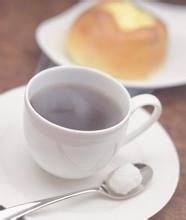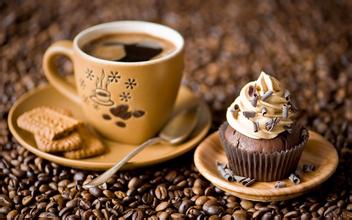Brewing method of high-quality coffee beans-diagram of brewing method of coffee powder
Brewing method of high-quality coffee beans-diagram of brewing method of coffee powder
1. Warm the cup. Everyone knows that the tannins in the coffee do not work as expected, making the coffee very sour, so we should pour hot water into the coffee cup before we start brewing the coffee.
two。 Grind beans. The thickness of hand-made coffee should also be adjusted according to the characteristics of coffee beans, and the powder thickness of deep-roasted coffee beans should be slightly thicker than that of medium-deep roasted beans. Specifically, the deep-roasted beans of carbon-roasted coffee are 4, while those of medium-and deep-roasted beans like Blue Mountain should be 3. 5. If the bean powder is too thick, the coffee is not strong enough, if it is too fine, the coffee will be very bitter. There is also the problem of the quantity of coffee beans. The amount of beans in a cup of coffee is 12-14g, while the quantity of 2 cups should be calculated by formula-2) X2, three or more cups is simple, 3 times 30g, 4 cups 40g, and so on.
3. Assemble utensils. Hand-brewed coffee is mainly composed of three parts, filter paper, filter cup and filter pot. If you pay attention to it, there should be an incubator under the filter pot to prevent the coffee from getting cold during brewing. The size specifications of filter paper, filter cup and filter pot should match. For example, two-person filter paper should be matched with two-person filter cup.
4. Transfer bean powder. Pour the ground bean powder into the combined filter paper, then gently pat the filter cup to pat the soybean powder and smooth the surface. So that the powder can receive water evenly in the following steps.
5. Warm the pot. Pour a small amount of hot water into the bottom pot, shake a few times, and then pour out. Then put the solid bean powder on the bottom pot.
6. It is stifling and steaming. The purpose of steaming is to stuffy the aroma of coffee and prepare for the second brewing. The steaming water temperature should be 93 degrees. Pour water from the center of the bean powder and circle it for 2-3 times, so that all the soybean powder can absorb water evenly. It is best to drop 3-5 drops of water. After absorbing water, soybean powder will expand, from the previous flat to the upward protruding arc. At this time, you can smell the faint fragrance of coffee powder. This step is particularly important and is one of the decisive factors in determining the success of a cup of coffee.
7. Brew. After steaming, put the kettle on a moist cloth to cool down. 25-30 seconds later, the water temperature drops to 89-91 degrees, and you can brew. Generally speaking, the brewing temperature of moderately roasted coffee beans (we call inert beans) is 91 degrees, which can better extract the aroma of coffee beans, while the brewing temperature of deep-roasted coffee beans (lively beans) is 89 degrees Celsius. This water temperature is enough to extract the aroma and bitterness of coffee beans. If the water temperature is too low, the water temperature is a little light, and the water temperature is too high. The brewing water can be a little thicker than the steaming one, but it must also be stable. The amount of coffee can be controlled by the number of laps and the speed of the current. Whether it is brewing one or three cups of coffee, the water simply needs to inject water in a circle from the center, then back to the center from the outer circle, to the center of the circle to collect water, and the brewing is over. In the brewing process, be sure not to wash the water into the filter paper, otherwise the coffee will be very astringent. Generally speaking, the amount of coffee brewed should be 0.5 more than the mark of the pot, otherwise the amount of coffee will not be enough.
8. Fill the cup. Shake the coffee in the pot gently before filling the cup so that it is fully mixed so that each cup of coffee tastes evenly. Then pour out the warm cup of water, pour the coffee into the cup and set the plate for dinner.
9. Matters needing attention. The whole coffee brewing process from warm cup to cup to drink (within 4 cups), the time should not be more than 2 minutes, otherwise the taste of coffee will become sour, astringent, and lose its original aroma.

Important Notice :
前街咖啡 FrontStreet Coffee has moved to new addredd:
FrontStreet Coffee Address: 315,Donghua East Road,GuangZhou
Tel:020 38364473
- Prev

Katim Coffee Bean Flavor description Grinding scale production area Variety treatment method Taste Manor introduction
Katim coffee bean flavor description grinding scale production area variety treatment method taste manor introduction 1. The state-owned Lujiang Farm in Baoshan City planted 12.6 mu in March 1991. The land was unshaded and irrigated once in the dry season. The level of management and fertilization was above. The average yield per mu was 75 kg in 1993, 350 kg in 1994 and 22 kg in 1995.
- Next

How to brew Yunnan small Coffee Flavor description Taste Grinding scale production area
How to brew Yunnan small-grain coffee flavor description taste grinding scale production area introduces that the quality of coffee depends on the growing environment, climate, cultivation and management techniques and other factors. Its best growing environment is low latitude, high altitude, sufficient rainfall and suitable sunshine, so the north latitude is 15. The ideal growing area for coffee is between the Tropic of Cancer and the Tropic of Cancer. But in other parts of this zone,
Related
- Detailed explanation of Jadeite planting Land in Panamanian Jadeite Manor introduction to the grading system of Jadeite competitive bidding, Red bid, Green bid and Rose Summer
- Story of Coffee planting in Brenka region of Costa Rica Stonehenge Manor anaerobic heavy honey treatment of flavor mouth
- What's on the barrel of Blue Mountain Coffee beans?
- Can American coffee also pull flowers? How to use hot American style to pull out a good-looking pattern?
- Can you make a cold extract with coffee beans? What is the right proportion for cold-extracted coffee formula?
- Indonesian PWN Gold Mandrine Coffee Origin Features Flavor How to Chong? Mandolin coffee is American.
- A brief introduction to the flavor characteristics of Brazilian yellow bourbon coffee beans
- What is the effect of different water quality on the flavor of cold-extracted coffee? What kind of water is best for brewing coffee?
- Why do you think of Rose Summer whenever you mention Panamanian coffee?
- Introduction to the characteristics of authentic blue mountain coffee bean producing areas? What is the CIB Coffee Authority in Jamaica?

